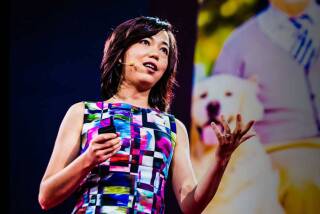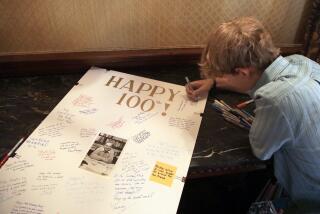Childhood Sparks to Science Careers
- Share via
As Wordsworth noted, “The child is father of the man.” So what books and toys from childhood influenced America’s top scientists and technologists to go into their chosen fields? Did any of those holiday gifts and books really matter?
The recollections of the following selection of science and technology notables don’t offer any “Rosebuds,” but they do offer some insight into what sparks youthful curiosity:
* Carver Mead, professor of electrical engineering at CalTech and pioneer in silicon chip design
“When I was a boy, about 6 or 7, I got a ‘Do-You-Know?’ book that was filled with neat things about inventions and inventors. . . . I also got a gift subscription every Christmas from my uncle for Popular Mechanics, and it was wonderful. . . . My father, who worked at an electrical power plant, also used to bring home batteries, and I would play with them and scrounge around for switches to build things.”
* John Seely Brown, director of Xerox’s Palo Alto Research Center
“I got a strobe light to play with when I was very young. I remember playing with a fan and being able to freeze time and figure out when a process was going and when it was stopped. I liked being able to feel that I was in control of time and motion.”
* Maxine Singer, president of the Carnegie Institution
“I remember Paul de Kruiff’s book ‘The Microbe Hunters.’ I was also influenced by the movie about the life of Marie Curie (the 1943 Warner Bros. production ‘Madame Curie,’ starring a post-Mrs. Miniver Greer Garson).”
* Dr. Anthony Fauci, director of the National Institute of Allergies and Infectious Diseases and leader of the U.S. government’s AIDS research program
“I could make something up for you, but it wouldn’t be the truth. . . . No toys and books that steered me toward science and medicine. . . . Certainly in high school, my desire to go into medicine was an evolution of values--family, social. . . . Maybe I’m odd that there wasn’t any specific thing. My interest in problem solving and my interest in people just evolved into my interest in medicine.”
* Ralph Gomory, president of the Sloan Foundation and formerly senior vice president of science and technology at IBM
“I read Paul de Kruiff’s ‘Microbe Hunters’ when I was 9 or so, and that really had a big influence.”
* Paul MacCready, president of AeroVironment and winner of the Kremer Prize for Human-Powered Flight
“Lincoln Logs and erector sets (and) three-dimensional puzzles. I did a lot with microfilm model airplanes. I did have a fly-powered model airplane; you put a fly in the refrigerator and that slows it down and makes it easier to glue onto the plane. I also remember making (hydrogen-based) fireworks. . . . I bet I was 12 when I did that.”
* Leroy Hood, director of the National Science Foundation’s Science and Technology Center for Molecular Biotechnology at CalTech and a pioneer in biotechnology instrumentation
“Actually, it was people who influenced me, not books or toys. The three best teachers I ever had were in my high school in Shelby, Mont. As a kid, I was enormously an outdoor person; I really enjoyed photography. My grandfather also ran a geology camp where I worked. But I also remember reading Scientific American in high school. That’s what really turned me on to biology.”
* Danny Hillis, co-founder of Thinking Machines Inc. and creator of the Connection Machine massively parallel supercomputer
“I would say Lego blocks and (the science fiction novel) ‘Have Space Suit, Will Travel’ by Robert Heinlein.”
* Walter Massey, director of the National Science Foundation
“I don’t remember any particular toy. . . . I had erector sets and toy trains, but I can’t honestly say they interested me in science. . . . I really liked science fiction. . . . I grew up in Mississippi, and I remember reading the magazine Amazing Stories at the local library. That got me more interested in how things worked, and that eventually led to my interest in science. . . . I liked science-fiction books, the paperbacks and the magazines. . . . I was a great fan and still am.”
More to Read
Sign up for our Book Club newsletter
Get the latest news, events and more from the Los Angeles Times Book Club, and help us get L.A. reading and talking.
You may occasionally receive promotional content from the Los Angeles Times.










